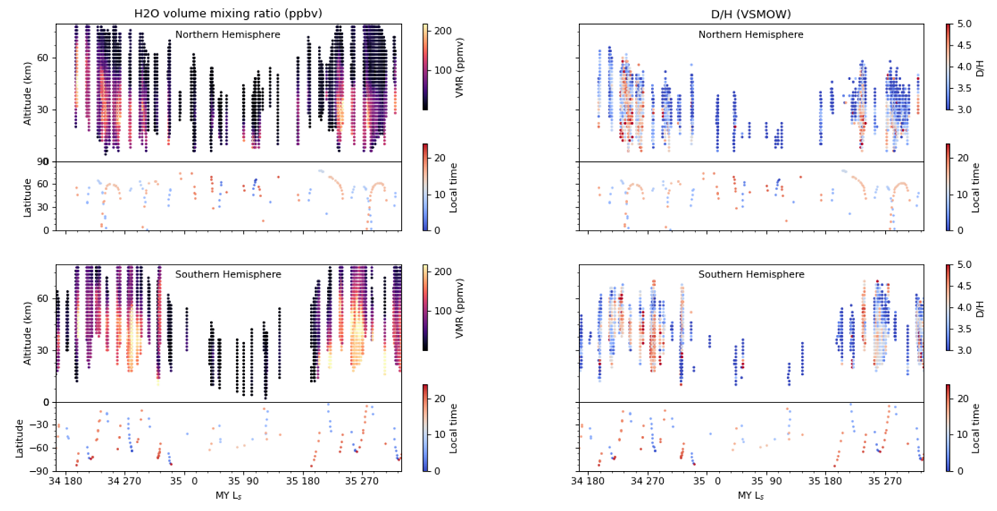Measurements of HDO and the D/H ratio in the Martian atmosphere from ACS MIR
- 1Laboratoire Atmosphères, Milieux, Observations Spatiales (LATMOS), UVSQ Université Paris-Saclay, Sorbonne Université, CNRS, Paris, France (ashwin.braude@latmos.ipsl.fr)
- 2Atmospheric, Oceanic and Planetary Physics, Oxford University, Oxford, UK
- 3School of Physical Sciences, The Open University, Milton Keynes, UK
- 4Space Research Institute (IKI) RAS, Moscow, Russia
- 5Université Paris-Saclay, CNRS, GEOPS, Orsay, France
Abstract
Measuring vertical variations in the deuterium to hydrogen ratio with altitude is essential in understanding the processes that lead to the escape of water vapour from the Martian atmosphere. We retrieve vertical profiles of HDO and H2O from the ACS instrument, monitoring seasonal changes particularly above the water condensation level. We discuss these results in relation to previously observed seasonal variations in D/H together with the expected variations from theoretical models.
Introduction
The ratio of deuterium to hydrogen (D/H) is a sensitive tracer of the rate of escape of water from the Martian atmosphere over its history. Hydrogen preferentially escapes from the atmosphere over its heavier isotope (e.g. [1]), and so the greater the amount of historical escape of water vapour, the larger the average D/H ratio. On Mars, this value is measured to be around 4-6 times that of terrestrial distilled ocean water [2,3], showing that the early atmosphere of Mars contained significantly more water than it does today. In addition, a number of processes in the lower and middle atmosphere can cause relative changes in the concentrations of semi-heavy water (HDO) with respect to water vapour, notably due to differences in rates of cloud deposition (e.g. [4,5]) and photolysis (e.g. [6,7]). We therefore wish to look at spatial and temporal changes in the vertical profile of D/H, particularly above the level of water condensation, in order to better characterise the processes that influence the escape of water vapour from the lower atmosphere into space.
Method
The mid-infrared channel of the Atmospheric Chemistry Suite Instrument (ACS MIR, [8]) on board the ExoMars Trace Gas Orbiter obtains transmission spectra of the Martian atmosphere in solar occultation geometry, which is sensitive to trace gases at very low abundance and at high vertical resolution. We make use of observations in grating position 11, which is sensitive to a wavenumber regime in which a large number of resolvable HDO lines are present that in the best cases provide sensitivity to HDO abundance up to around 70 km. These are then inverted using the RISOTTO radiative transfer and retrieval pipeline [9,10] to give vertical profiles of HDO volume mixing ratio. Concurrent vertical profiles of H2O are obtained using the near-infrared (NIR) channel of the same instrument [11], and then the D/H ratio computed assuming that H2O and HDO are the main carriers of the two isotopes of hydrogen. Accurate quality control of the data is performed using probability-sparse Non-negative Matrix Factorisation (psNMF [12,13]).
Results and Perspective
We report seasonal changes in the fractionation of D/H in the middle atmosphere throughout the temporal range of the data starting from the autumn equinox in MY34 to the end of MY 35. These will be discussed in relation to the findings of seasonal changes in the vertical profiles of D/H reported by the NOMAD instrument [14], and the results interpreted in relation to predictions from Global Climate Models (GCMs) of HDO ([5,15,16]).

Fig. 1: Retrieved vertical profiles of (left) water vapour from (right) D/H from the near- and mid-infrared channels respectively of the ACS instrument.
References
[1] Krasnopolsky, V. A., Mumma, M. J., & Randall Gladstone, G. 1998, Science, 280, 1576
[2] Owen, T., Maillard, J. P., de Bergh, C., et al. 1988, Science, 240, 1767-1770
[3] Webster, C. R.; Mahaffy, P. R.; Flesch, G. J., et al. 2013, Science, 341, 260-263
[4] Fouchet, T. & Lellouch, E. 2000, Icarus, 144, 114-123
[5] Montmessin, F., Fouchet, T. & Forget, F. 2005, J. Geophys. Res. Plan., 110
[6] Yung, Y. L., Wen, J.-S., Pinto, J. P., et al. 1988, Icarus 76, 146-159
[7] Alday, J., Trokhimovskiy, A., Irwin, P. G. J., et al. 2021, Nat. As. 5, 943-950
[8] Korablev, O., Montmessin, F., Trokhimovskiy, A., et al. 2018, Space Sci. Rev.,214,7
[9] Braude, A. S., Ferron, S., & Montmessin, F. 2021, J. Quant. Spec. Rad. Transf.,274,107848
[10] Braude, A. S., Montmessin, F., Olsen, K. S., et al. 2022, A&A,658,A86
[11] Fedorova, A. A., Montmessin, F., Korablev, O., et al. 2020, Science 367, 297-300
[12] Hinrich, J.L. & Mørup, M. 2018, Latent Variable Analysis and Signal Separation. LVA/ICA 2018. Lecture Notes in Computer Science(), 10891, 488–498
[13] Schmidt, F.; Mermy, G. C.; Erwin, J., et al. 2021, JQSRT, 259, 107361
[14] Villanueva, G. L.; Liuzzi, G.; Crismani, M. M. J., et al. 2021, Sci. Adv. 7, eabc8843
[15] Rossi, L., Vals, M., Montmessin, F., et al., J. Geophys. Res. Plan., in review.
[16] Vals, M., Rossi, L., Montmessin, F., et al. 2022, J. Geophys. Res. Plan., in press.
How to cite: Braude, A., Montmessin, F., Olsen, K., Vals, M., Alday, J., Rossi, L., Trokhimovskiy, A., Fedorova, A., Schmidt, F., Korablev, O., Lefèvre, F., Baggio, L., Irbah, A., Lacombe, G., Patrakeev, A., and Shakun, A.: Measurements of HDO and the D/H ratio in the Martian atmosphere from ACS MIR, Europlanet Science Congress 2022, Granada, Spain, 18–23 Sep 2022, EPSC2022-696, https://doi.org/10.5194/epsc2022-696, 2022.

